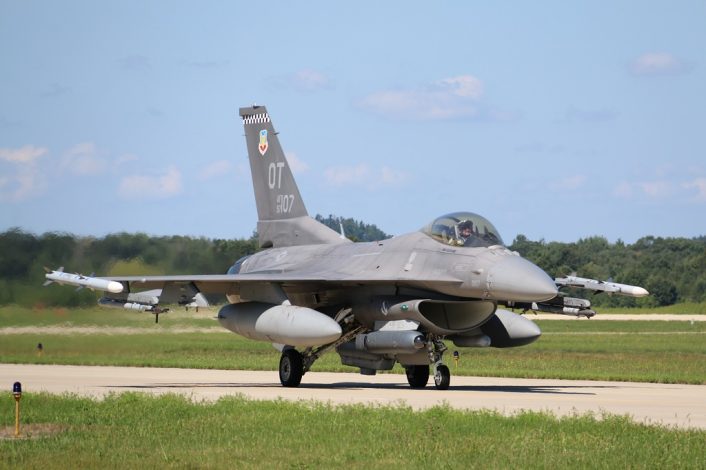The new suite was tested on the company’s flying testbed in conjunction with the APG-83 SABR AESA radar during Exercise Northern Lightning.
Northrop Grumman recently announced that the new Next Generation Electronic Warfare (NGEW) system was tested for the first time joined the AN/APG-83 Scalable Agile Beam Radar (SABR) at Exercise Northern Lightning, demonstrating the full interoperability of the two systems in a realistic and contested electromagnetic spectrum environment. The company used one of their flying testbeds, a CRJ-700 equipped with NGEW and a SABR radar inside an F-16’s nosecone.
“When an EW system and a radar are able to work together fully, as demonstrated with NGEW and SABR, pilots can take advantage of capability without compromise,” said James Conroy, vice president, navigation, targeting and survivability, Northrop Grumman. “With the radio frequency (RF) spectrum becoming increasingly contested, this critical set of capabilities will support the F-16 for many years to come.”
According to Northrop Grumman, NGEW and SABR demonstrated full pulse-to-pulse, multi-function interoperability in a contested operational environment. With SABR successfully engaging multiple air and ground targets, NGEW detected and identified a range of advanced threats, employing advanced jamming techniques capable of defeating those threats when required.
The company worked alongside the 85th Test and Evaluation Squadron, the Operational Flight Program Combined Test Force and the F-16 system program office to test the new EW suite, which includes a new Digital Radar Warning Receiver, state of the art antennas and processors, and a digital frequency memory internal jammer. “During Northern Lightning we gained valuable insight on NGEW capabilities and obtained over 170 test points against both air and ground emitters,” said Lt. Col. Stephen Graham, F-16 electronic warfare test director, OFP CTF. “We are one step closer to installing the first NGEW suite on an Eglin F-16 in less than one year.”
Northern Lightning set the right environment to demonstrate NGEW’s compatibility with the Active Electronically Scanned Array (AESA) radar while identifying jamming threats across the Radio Frequency spectrum. In fact, during the exercise, the two systems faced a high-density radio frequency environment generated by the Joint Threat Emitters of the Volk Field Combat Readiness Training Center. These threat emitters allowed Northern Lightning participants to fly missions under conditions representative of near-peer electromagnetic spectrum environments.
NGEW leverages an open-systems, ultra-wideband architecture, providing the instantaneous bandwidth needed to defeat modern threats. As RF threats continue to proliferate, effective electronic warfare systems are urgently needed to keep pilots safe and ensure mission success. “There is a strong push to improve Electronic Protection for the F-16 against modern adversaries,” said Lt. Col. Graham. “NL21 allowed for both an RF dense environment while permitting targeted testing before, during, and after LFE fights.”

The Air Force awarded a contract to Northrop Grumman in late 2020 for the development of NGEW, with the goal of equipping as many as 450 F-16s if the testing is successful. An interesting point added by Northrop Grumman is that the EW suite being developed for the Viper (as the F-16 is nicknamed by its crews) is part of a product line of electronic warfare capabilities that can be adapted to protect virtually any platform, which shares a common technology baseline with the already known AC/MC-130J Radio Frequency Countermeasures (RFCM).
Another interesting aspect pulse-to-pulse interoperability of NGEW with the F-16’s newly acquired APG-83 radar which has been declared fully operational with the Air National Guard in October 2020. While not better specified, this should mean that the two systems are interoperable without generating significant interferences and maybe, coupled together, the AESA radar and the new EW suite could provide some additional advanced capabilities that would not be available with a mechanical radar.
Exercise Northern Lightning was also the right occasion to introduce the latest F-16 software in a Large Force Exercise, “graduating” the F-16 Mission Modular Computer M7.3 which hosts the new software for the jet. The next step will be releasing the software to the Combat Air Forces where the F-16 fleet as a whole will receive an update in its avionics and weapons system with enhanced capabilities to improve air-to-air capabilities and targeting accuracy, enabling new combat capabilities.
“The F-16 is rapidly improving its combat capability to stay relevant in a near-peer fight and the dedication of the F-16 test community is evident in accelerating change to the CAF,” said Capt Michael Mclain, chief of standardization and evaluation at the 85th Test and Evaluation Squadron. The F-16 testing also saw the integration of Lockheed Martin’s Legion Pod equipped with Infrared Search and Tracking System technology.
“We were able to achieve what usually takes three to six months of testing in a matter of weeks,” said Lt Col. Jeremy Castor, F-16 sensors program manager, OFP CTF. “This has all to do with the collaboration that took place between the Lockheed Martin team and the operators out in the field who would test the infrared search and track technology during every sortie then retract the data and re-program the pod to better equip the warfighter in our combat scenarios.”









